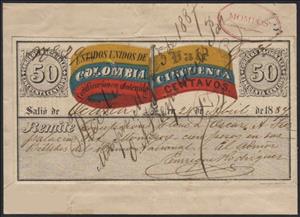Stamp: Flagpole centred (Colombia 1880)
Flagpole centred (Colombia 1880)
01 January (Colombia ) within release Insured Letter Stamps goes into circulation Stamp Flagpole centred face value 50 Colombian centavo
| Stamp Flagpole centred in catalogues | |
|---|---|
| Michel: | Mi: CO-WB 5b |
Stamp is square format.
COLOMBIA CINCUENTA inside flage is white. CENTAVOS inside flag unshaded. Year inscribed "18" Various forgeries exist. "...Thanks to the Postal Services law of April 29, 1865, a new system of insured letter stamps, unique to Colombia, to be used by the public to send money and valuables, was approved. The stamp paid both the basic postage rate and the insurance fee, complying also as registration and proof of delivery receipt. They are commonly called 'cubiertas' because they were affixed to the back of the cover to seal it after the contents was verified. Cubiertas were not sold to the public as stamps did. The sender bring the unsealed addressed envelope to the post office where an official verify the contents, fulfill all data in the cubierta and seal the envelope with it. Upon receipt the addressee has to open the envelope in the presence of a post officer, confirm the contents and acknowledge receipt signing the cubierta. Generally, the cubierta was cut or torn off from cover -reason why there are so few surviving covers and the poor condition of many "cubiertas"- and sent back to the origin post office where it was archived as proof of delivery. (Author: Dario Diaz)Stamp Flagpole centred it reflects the thematic directions:
A flag is a piece of fabric (most often rectangular or quadrilateral) with a distinctive design that is used as a symbol, as a signaling device, or as decoration. The term flag is also used to refer to the graphic design employed, and flags have since evolved into a general tool for rudimentary signalling and identification, especially in environments where communication is similarly challenging (such as the maritime environment where semaphore is used). National flags are patriotic symbols with varied wide-ranging interpretations, often including strong military associations due to their original and ongoing military uses. Flags are also used in messaging, advertising, or for other decorative purposes. The study of flags is known as vexillology, from the Latin word vexillum, meaning flag or banner.
A number is a mathematical object used to count, measure, and label. The most basic examples are the natural numbers 1, 2, 3, 4, and so forth. Numbers can be represented in language with number words. More universally, individual numbers can be represented by symbols, called numerals; for example, "5" is a numeral that represents the number five. As only a relatively small number of symbols can be memorized, basic numerals are commonly organized in a numeral system, which is an organized way to represent any number. The most common numeral system is the Hindu–Arabic numeral system, which allows for the representation of any non-negative integer using a combination of ten fundamental numeric symbols, called digits. In addition to their use in counting and measuring, numerals are often used for labels (as with telephone numbers), for ordering (as with serial numbers), and for codes (as with ISBNs). In common usage, a numeral is not clearly distinguished from the number that it represents.


